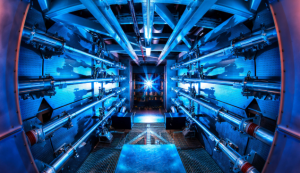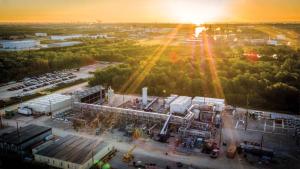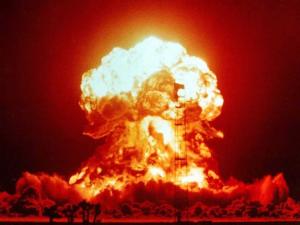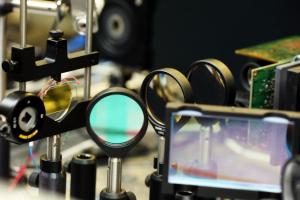LAB REPORT
Science and Technology Making Headlines
June 2, 2017


The National Ignition Facility is the largest and most energetic laser in the world.
That’s one mean, lean laser machine
The big machines of science are large and smart. From the largest laser in the world to earthquake emitters; from space-faring weightless halls to subterranean subatomic particle slammers: These powerhouses were built for discovery. When it comes to science, brawn can be brilliant.
Lawrence Livermore’s National Ignition Facility fits the bill.
Why build a laser when you could build 192 lasers? All those beams focus on one BB-size target, and it feels the pressure -- more than 100 billion times the force of Earth’s atmosphere. The real aim is to turn a single, tiny hydrogen seed into a starlike explosion. Cue fantasies of full-on fusion that could power futuristic homes around the globe. This extreme experiment is inspired by the reactions that power the sun, so it’s no sweat for temps to reach 180 million degrees Fahrenheit. More than 40,000 mirrors and optical components make for one super superlaser.


The NET Power plant near Houston, Texas, is testing an emission-free technology designed to compete with conventional fossil power.
Goodbye smokestacks, hello clean air
The Houston area emits more carbon dioxide (CO2) than any other place else in the United States.
But on the eastern edge of that CO2 hot spot, a new fossil fuel power plant showcases a potential remedy for Houston's outsized greenhouse gas footprint. The facility looks suspiciously like its greenhouse gas emitting predecessor, a complex the size of two U.S. football fields, chock-a-block with snaking pipes and pumps. It has a turbine and a combustor. But there is one thing it doesn't need: smokestacks.
When that 25-megawatt demonstration plant, funded by NET Power, is fired up later this year, it will burn natural gas in pure oxygen. The result: a stream of nearly pure CO2, which can be piped away and stored underground or blasted into depleted oil reservoirs to free more oil, a process called enhanced oil recovery (EOR).
"For many CCS projects, the upfront costs are daunting," says Julio Friedmann, a carbon capture expert at Lawrence Livermore National Laboratory. "Avoiding those costs really matters." Unlike gas plants without carbon capture, NET Power will be able to sell its CO2 for EOR.


The fireball of a nuclear explosion.
Stay away from that car
Nuclear blasts create fallout, which can harm you with large doses of radiation. Cars offer little protection from fallout.
A surer way to survive in the aftermath of a nuclear explosion is to go indoors, stay put and listen to the radio.
More than 14,900 nuclear weapons exist in the world, and kiloton-class nukes are proliferating in weapons stockpiles. In fact, a nuclear detonation of 10 kilotons or less by a terrorist is one of 15 disaster scenarios for which the U.S. government has planned.
There is one thing you should never do, according to Brooke Buddemeier, a health physicist and radiation expert at Lawrence Livermore National Laboratory.
"Don't get in your car," said “Don't try to drive, and don't assume that the glass and metal of a vehicle can protect you.”


LLNL researchers developed a new 3D printing method that would allow them to print large metal objects in a fraction of the time needed for metal 3D printers on the market today. Photo by Kate Hunts/LLNL
Revolution in evolution of 3D printing
A technology originally developed to smooth out and pattern high-powered laser beams for the National Ignition Facility (NIF) can be used to 3D print metal objects faster than ever before.
This new method -- Diode-based Additive Manufacturing (DiAM) -- allows for large metal objects to be printed in a fraction of the time needed for metal 3D printers on the market today, expanding possibilities for industries requiring larger metal parts, such as aerospace and automotive.
"By cutting the print time and having the ability to upscale, this process could revolutionize metal additive manufacturing," said Ibo Matthews, an LLNL scientist heading the research.
The combination of speed and degree of design flexibility afforded through the DiAM method, is potentially "far beyond" that of current powder-bed fusion-based systems.


LLNL researchers have reported the synthesis of 3D printed transparent glass components using a slurry of silica particles extruded through a direct-ink writing process. From left: LLNL chemical engineer Rebecca Dylla-Spears and LLNL materials engineer Du Nguyen.
Need glass? Push print
Lawrence Livermore scientists and academic collaborators have made transparent glass through 3D printing, a development that could ultimately lead to altering the design and structure of lasers and other devices that incorporate optics.
Other research institutions have shown 3D printing of glass is possible, however, prior demonstrations have involved extruding molten glass filaments through a heated print-head or using lasers to selectively melt and fuse glass powders. With these methods, the powders and filaments don't fully meld together in the short times they are heated during the printing process, which leads to porous or non-uniform structures that would not be suitable for optical applications.
Lawrence Livermore's approach does not rely on printing molten glass; instead the researchers create custom inks that are formed from concentrated suspensions of glass particles with highly controlled flow properties so they can be printed at room temperature. The printed components then undergo a carefully designed thermal treatment to densify the parts and remove evidence of the printing process. Finally, the processed parts are given an optical quality polish.





